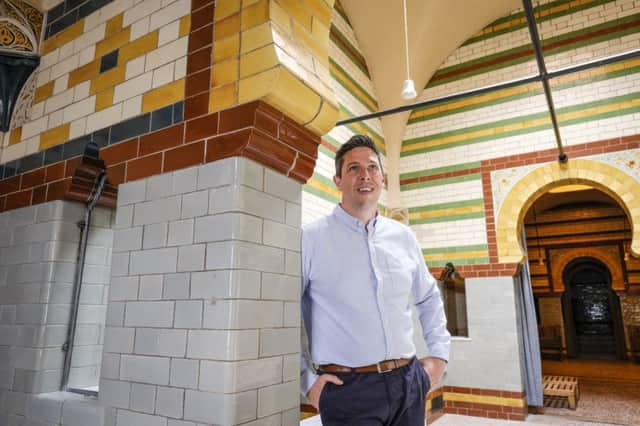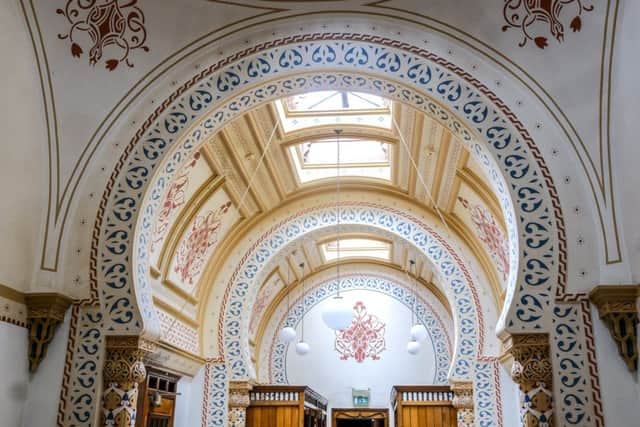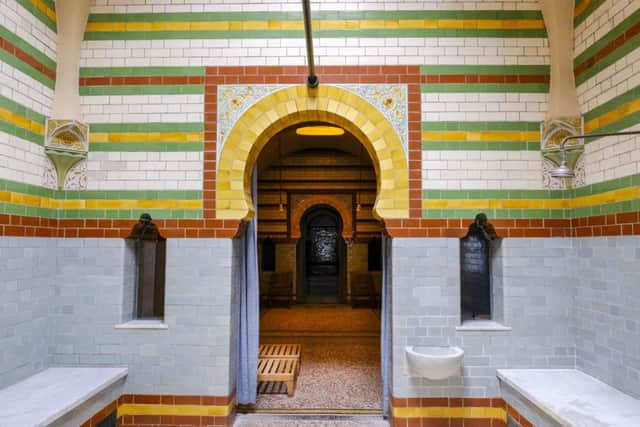Turkish delight as Victorian treasures revealed


But the ornate and unique detailing that made Harrogate’s Turkish baths the most spectacular outside Turkey itself had long since been hidden beneath faceless, stucco walls.
Now, three decades after the baths themselves were restored, the original decor is being exposed to a new generation of health seekers.
Advertisement
Hide AdAdvertisement
Hide AdAround £300,000 is being spent on what remain the most complete Victorian Turkish baths in Europe, to restore the public areas to their original grandeur.


The work will see elaborate Islamic arches, painted ceilings and terrazzo floors uncovered, as well as an original room blocked off for decades.
“The building has been treated disappointingly by certain builders over the years,” said its manager, Chris Mason.
“The baths themselves were restored in the 1980s, but it’s really great now to begin to see the tile work and other features that have been hidden.
Advertisement
Hide AdAdvertisement
Hide Ad“We are also improving the entrance, reception area and spa room, using original tiling where possible.


“Visitors will see the building in its best light from the moment they walk in. The work will let it sing and speak for itself.”
There were more than 600 dry hot air baths in Britain and Ireland by the end of the 19th century, but Harrogate’s, built by craftsmen from Italy and Poland and opened in 1897, was considered the finest. Its clientele was said to have included Alexandra Feodorovna, wife of Tsar Nicholas II, and her sister, Victoria Mountbatten, Marchioness of Milford Haven.
Only seven of the original baths survive, in various states of completeness.
Advertisement
Hide AdAdvertisement
Hide AdIn Harrogate, England’s pre-eminent spa town in the late Victorian age, the Turkish baths were among many facilities available to well-heeled visitors who had come to take the waters and seek respite for rheumatism, sciatica and arthritis. Other treatments included a medicinal waters dispensary, hydrotherapy, mud baths and steam rooms.
The sulphur and salt baths have long gone, and the Royal Baths building, of the Turkish baths were part, now houses an elaborate Chinese restaurant and a Wetherspoon’s pub.
However, the refurbishment will allow the revival of one Victorian facility – the dedicated rubdown room.
Around 40,000 visitors a year come to the council-owned baths, following the time-honoured “hammam” ritual of heating, cooling and cleansing in progressively warmer chambers, before cooling down in the plunge pool, visiting the steam room, or the frigidarium.
Advertisement
Hide AdAdvertisement
Hide AdMr Mason said: “With the modern coverings ripped out the original architecture exposed, the baths here will be a long way from any of the normal day spas that are our competition these days.”
Nicola Baxter, assistant curator of museums in Harrogate, added: “There are other places that offer spa treatments but these are the best historically preserved Turkish baths in Europe, in their original building, so their appeal is unique.”
The baths were the subject of several previous restorations, most recently in 2003, backed by the Heritage Lottery Fund.
Their popularity was said to have soared in the following years, although in 2011, Harrogate council had to ban men-only sessions after reports leaked from the town hall of “inappropriate behaviour”.